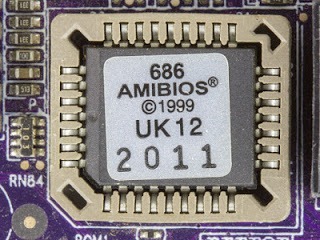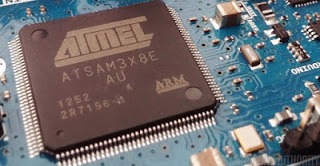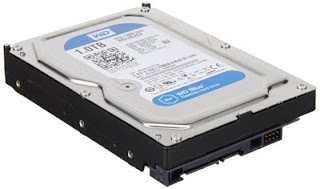The BIOS
This contains instructions which are specific for that particular motherboard. Those programs and instructions will remain in the PC throughout its life; usually they are not altered. However, it is possible to get replacement / upgrade BIOS’s. Primarily the ROM code holds start-up instructions. In fact there are several different programs inside the start-up instructions, but for most users, they are all woven together. You can differentiate between:
* POST (Power On Self Test)
* The Setup instructions, which connect with the CMOS instructions
* BIOS instructions, which connect with the various hardware peripherals
* The Boot instructions, which call the operating system (DOS, OS/2, or Windows)
Note: Only very old or different OS’s are stored on ROM, such as OS/2. This is actually a much more efficient system.BIOS’s are static sensitive, so take care when handling them. They can also be PWord protected… if you ever get round to doing this, don’t forget the password. As you don’t use the BIOS PWord often, this is easy to do. Don’t. it’s bloody hard getting the PWord back.
Processors
Processors work on a fetch-execute cycle. each tick of the clock, in theory, they get a bit of data… and by tick of the clock here, we don’t mean a second, we mean the tick of a computer clock. Depending on the speed of your processor, this is anywhere from 233 million ticks per second for a 233, to 800 for an overclocked 600MHz Athlon chip.
So, you can get, on your average computer, 400 – 500 bits of data per second. Well, wrong actually… because not every clock tick is taken up by getting the data. Every _fourth_ is. Well, what about every other 3? you ask.. they are taken up with _finding_ the data, _getting_ it, and putting it back. So, you say, your processor runs at a quarter of the speed that in theory it should be able to do? Well, yes. And there’s no way around this, unfortunately. But, we can make the clock speed a little faster, and it is the clock speed that dictates the speed of the processor… (within reason).
Therefore, you can set the clock ticks on your 233 to 266, and it’ll run at 166 MHz. Yes. Unfortunately, the more clock ticks there are in relation to what your chip is _supposed_ to run at, the hotter it Gets. Therefore, you need to install heatsyncs/fans. In fact, the AMD Athlon 600MHz overclocked to 800MHz, the fastest PC at the time of writing has a minature fridge that cools the chip, which is its own special metal box. The tower-sized case also has a box the size of a mini-tower underneath for the cooling system. 😉
For this increase in temperature of 200MHz, the chip is cooled to -37 degrees centigrade. that’s cold. 😉 (Note: AMD chips generally run a lot hotter than Intel ones). ((Not a problem unless u have no heatsync)) – see the micron section, below…
The Clock
Now, this fabled clock looks like, in most cases, a small black box on your motherboard. The clock ticks it emitts are in the form of a wave , but a different wave: one that is sqare, and it looks like a castle ramparts. the speed of this is dictated by the MHx setting you set with the Jumpers on your motherboard. The waves look like so: (except slightly more square)
__ _ ____ _ _ ___
_¦ ¦___¦ ¦__¦ ¦_¦ ¦_¦ ¦__¦ ¦__ and etc.
The wave, which never changes, and is always the same, is broadcast throughout your motherboard, and it synchronises all of the things that go on there. For example, when you press the left button in your game of quake, the processor assigns different bits of your computer to do whatever is neccacery to redraw what’s on the screen, and tells it to have it done in 3 ticks’ time. The same process occurs on the gfx card itself, where the main processor assigns a polygon to each other chip, or whatever. Infact, if you have an old enough computer, you can see it being redrawn on the screen… try it… run a gfx-intensive game on a 486… If the task isn’t done in time, then it all falls apart, and the computer crashes. This is why you don’t want to buy a dodgy CPU. 🙂 (Get an AMD Athlon!).
The signals sent run around your motherboard, through all of those copper bits, and into the chips, ISA slots, or whatever, and the task gets accomplished.
This signal is sent around the motherboard in that most wonderful of things we all love, Binary. Now, Binary is what Computers communicate with, and it is a DIGITAL thing. Digital. A Much used term.
Computers are electronic, and therefore, all the signals in them are tiny pulses of electricity. Now, electricity can be one of two things. On… or off. And this is what makes it digital. If it could be half on as well, it would be analogue… But no. It’s digital. However, the representation of it in the form of signals down wires is analogue, as a sound in a modem wire can be any of a hundred million different pitches, can’t it. Yes. This digital signal is, then, a series of 0’s and 1’s. Binary. The counting system that we use (1, 2, 3, 4, 5, 6, 7, 8, 9, 10, 11… etc… ) is Denary. It’s Base ten… Binary is Base 2 (and Hexadecimal, which is used, amongst other things, is base 16). Therefore it is perfect for being what these signals are coded in. so each charactor on your screen is represented in your computers RAM by a series of Binary digits. Probably 8. if you go into Windows Calculator, and switch to scientific mode (View>Scientific) you can decode this. For example, 1 in Binary is 00000001. 2 is 00000010. The way this can be decoded is thus:
Each digit in binary represents a quantity of a certain number, just as denary does. In denary, there is a column for 1’s, a column for 10’s, and a column for 100’s. And in Binary, there is a column for 1’s, 2’s, 4’s, 8’s, etc. Let me show you:
Denary:
100s 10s 1s
1 0 0
Here, there is a one in the hundreds column, and therefore, 100 + 0 + 0 (0 and 0 are the other 2 columns) makes 100. SO 1 0 0 in Denary represents 100. (of course, translating 100 –> 100 doesn’t work, as denary is used in both cases). In Binary, this works this:
Binary (8-bit — 8 digits)
128 64 32 16 8 4 2 1
1 1 1 1 1 0 1 0
SO… 128 + 64 + 32 + 16 + 8 + 2 + 1 = 250.
So the Binary number 11111010 = 250. Simple, eh?
It is possible to do addition, subtraction, multiplication, in fact, EVEYTHING that is possible with denary (1–> 10)… I’m not going to explain it because it is simply too complicated. 😉 Use Windows Calculator… the radio buttons at the top left switch between number systems.
Chipset
We all know what assembly language is, do we not? It is the programming language that is most native to a computer. The instructions go directly to the chip (more or less). (Assembly actually lays on top of Machine code, which is the real native: Assembler is a more human-friendly version)… Each chip has their own different version of assembler/machine code, called its _chipset_. Each new type of chip comes with an upgraded chipset: for example, the Intel MMX chip incorporated the…wait for it… MMX chipset! There are also chipsets such as 3D!Now. THe most basic of commands between, say, Intel and AMD are the same: they have to be in order for the two to be compatible, but more advanced things are different. This is why Alpha chips are incompatible with windows: The chipset is completely different.
Intel has hitherto been the leader in supplying chip sets to the Pentium motherboard. Therefore, let us just mention their chip sets, which have astronomical names. The Neptune chip set (82434NX) was introduced in June 1994. It replaced the Mercury set (82434LX). In both chip sets, there were problems with the PCI bus. In January 1995 Intel introduced the first Triton, where everything worked. This chip set supports some new features: it supports EDO RAM, and it offers bus master integrated EIDE control and NSP (Native Signal Processing – one of the many new creations, which was soon forgotten).
The sorts of things that new chipsets are used for are varied… for example, The Intel TX Chipset, for example, supports SDRam and UltraDMA (But the TX-set cannot cache above 64 MB RAM, and that is a problem.), while AMD chips have their own special Graphics chipset, which is better for that task.
Microns
The CPUs have doubled their calculating capacity every 18 months. This is called “Moore’s Law” and was predicted in 1965 by Gordon Moore. He was right for more than 30 years. The latest CPUs use internal wiring only 0.25 microns wide (1/400 of a human hair). But if Moore’s Law has to be valid into the next century, more transistors have to be squeezed onto silicon layers. And now there is a new hope. IBM has for the first time succeeded in making copper conductors instead of aluminum. Copper is cheaper and faster, but the problem was to isolate it from the silicon. The problem has been solved with a new type of coating, and now chips can be designed with 0.13 micron technology. The technology is expected later to work with just 0.05 micron wiring! Texas Instruments announced on August 27th 1998 that they expect 0.07 micron CMOS processing in the year 2001. At the time of writing, AMD chips run at .27 microns (?) and Intel at .33. This explains why AMD chips are hotter, as there is less wire, and therefore more probability of the electrons that the electricity is comprised of hitting the side of the wires, and creating heat.
Hard Drives
Hard drives work in much the same way as a floppy disk does. They can, however, store a much larger capacity of data, and therefore are much more fragile, and compact . For this reason, they are hermetically sealed. NEVER OPEN ONE IF YOU WANT TO USE IT AGAIN. There is, inside, 3 or 4 goldy-brown circular plates on which the data is stored. These are much the same as the ones inside a floppy disk, except that they are not ‘floppy’ but hard, or stiff. The data is stored on the platters magnetically, which explains why floppy disks have a “keep magnets away from me” warning on boxes u buy them in.
IBM introduced the first hard disk in 1957, when data usually was stored on tapes. The first 305 RAMAC (Random Access Method of Accounting and Control) consisted of 50 platters, 24 inch diameter, with a total capacity of 5 MB, a huge storage medium for its time. It cost $35,000 annually in leasing fees (IBM would not sell it outright) and was twice the size of a refrigerator.
In the early 80s, HD’s became the preferred storage medium as opposed to floppy drives (these were previously used due to increased reliability). IBM’s PS/2 (one of which I have – yay) was one of the first PCs to be equipped with a Hard drive. I think.
Mice
Mice are, as we all know, Input devices, and as we also know, they tell where you are on the mousemat by moving a ball in the bottom. Which you can see. But how does it read how the ball is moving? Well, inside the mouse are 2 rollers, at 90 degrees to each other. When you move the mouse, u move the ball, and thus the rollers. THe rollers have some little discs on the end of them with slits in, and either side of the disc are light-readers, so that when you move tha ball, the mouse can tell because light flasles on and off in its light reader. There is also a 3rd non-functional roller to keep the ball rolling smoothly. Note: It is perfectly safe to turn your mouse upside down ,. take the ball out and look inside, as long as you don’t prod anything too hard (twiddle the rollers by all means, just don’t stick bits of paper in there). It is also a good idea to get a blunt knife or screw driver and clean the crud off the rollers every few weeks… it solidifies into little rings around the rollers, and works to the detriment of the mouse. If it isn’t cleaned off, it can also, fallinto the mouse, and reak havok with the insides. 🙂 The same sort of crud builds up in keyboards, but is harder to remove. 😉
GFX Cards
A video card is typically an adapter, a removable expansion card in the PC. Thus, it can be replaced! The video card can also be an integral part of the system board…This is the case in certain brands of PCs and is always the case in lap tops. This is not nice, as it is hard to upgrade to a better card. On a OC with a non-removable gfx or sound card, the normal procedure if you _do_ want to replace it is to disable the built-in graphics card using jumpers or dip switches… consult your motherboard manual. 😉 Regardless of whether it is replaceable or integrated, it consists of three components:
* A video chip of some brand (ATI, Matrox, S3, Cirrus Logic, or Tseng, to name some of the better known). The video chip creates the signals, which the screen must receive to form an image.
* Some kind of RAM (EDO, SGRAM, or VRAM, which are all variations of the regular RAM). Memory is necessary, since the video card must be able to remember a complete screen image at any time.
* A RAMDAC – a chip converting digital/analog signals.









